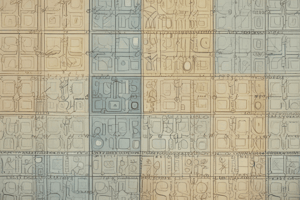Podcast
Questions and Answers
Match the following terms with their descriptions:
Match the following terms with their descriptions:
Phenotype = Physical expression of an organism's genetic makeup Genotype = Genetic makeup of an organism Punnett Square = Tool used to predict offspring genotypes from parental genotypes Mendelian Genetics = Principles of inheritance based on Gregor Mendel's work
Match the following actions with their correct steps in building a Punnett Square:
Match the following actions with their correct steps in building a Punnett Square:
Writing down parental genotypes = First row and first column of a 2x2 grid Filling in genotype combinations = Using rules of probability in the grid Dihybrid crosses = Filling in genotypes of parental alleles in first and second columns Adding remaining alleles = Second row of the grid for dihybrid crosses
Match the following uses with the applications of Punnett Squares:
Match the following uses with the applications of Punnett Squares:
Predicting phenotypes = Understanding how genotypes influence physical traits Revealing allele inheritance = Showing how dominant and recessive alleles are passed down Population genetics = Studying how genotypes manifest in a group Parental crosses = Predicting offspring genotypes from known parent genotypes
Match the following terms with their applications in genetics:
Match the following terms with their applications in genetics:
Match the following with their definitions:
Match the following with their definitions:
Match the following with their applications:
Match the following with their applications:
Match the following with their examples:
Match the following with their examples:
Match the following with their significance:
Match the following with their significance:
Match the following with their illustration tools:
Match the following with their illustration tools:
Match the following with their complexity levels:
Match the following with their complexity levels:
Flashcards are hidden until you start studying
Study Notes
Punnett Square: A Genetic Powerhouse
Imagine you've got a box of crayons, and you're curious about the colors that might pop out when you mix two at random. That's a little like working with genes and their expressions, which we call phenotypes. Punnett squares, a simple yet powerful tool in genetics, help us predict the outcome of genetic crosses, just like predicting the colors in our crayon box.
The Basics of Punnett Squares
Punnett squares are diagrams used to predict the genotypes of offspring from a cross between two parent organisms based on their known genotypes. They're named after their inventor, geneticist Reginald Punnett, and are used to illustrate the principles of Mendelian genetics.
To build a Punnett square:
- Write down the parental genotypes in the first row and first column of a 2x2 grid.
- Fill in the genotype combinations in the grid using the rules of probability.
- For dihybrid crosses, fill in the genotypes of the parental alleles in the first and second columns, then add the remaining alleles in the second row.
Applications of Punnett Squares
Punnett squares are useful for predicting the genotypes of offspring from a cross between two parent organisms, revealing how dominant and recessive alleles are inherited. They are commonly used when:
- Predicting phenotypes based on genotypes: By examining the genotypes of offspring, we can understand how genotypes influence phenotypes in a population.
- Identifying monohybrid crosses: These crosses involve a single pair of alleles, and Punnett squares help illustrate the proportions of genotypes in the offspring population.
- Identifying dihybrid crosses: More complex crosses involving two pairs of alleles, such as those responsible for eye color and flower color, can be analyzed using Punnett squares.
- Teaching genetics: Punnett squares are a visual tool that helps illustrate the principles of Mendelian genetics, making them ideal for teaching and learning.
Phenotypes and Genotypes
Genotypes are the actual genetic makeup of an organism, referring to the specific alleles (versions) of genes they possess. They are represented by letters, such as A and a. Phenotypes, on the other hand, are the observable characteristics of an organism that result from the interaction of its genotypes and environmental factors.
Understanding the relationship between genotypes and phenotypes is crucial when analyzing the results of Punnett squares. For example, consider a plant with two possible flower colors, red (RR) and white (rr), where R is the dominant allele and r is recessive. If we cross two heterozygous plants (Rr × Rr), we can create a Punnett square to predict the genotypes and phenotypes of the offspring.

In this example, the genotypes of the offspring are 1:1 RR to rr, and the phenotypes are 3:1 red to white, as predicted by the Punnett square.
Punnett squares are a vital tool in genetics education and research, helping us understand the inheritance of genetic traits. By predicting genotypes, we can better understand the factors that influence phenotypes and how they are passed down between generations.
Studying That Suits You
Use AI to generate personalized quizzes and flashcards to suit your learning preferences.




